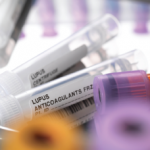To illustrate clinical needs in the lupus field, Dr. Furie looked at the placebo arms of nine clinical trials studying patients on standard treatments. In extra-renal disease, response rates were no higher than 50%, depending on the trial and the endpoint used. In lupus nephritis, none of the trials had a complete response rate above 36%.
“We have major unmet needs in lupus,” he said.
He mentioned four main problems with lupus clinical trials. For one thing, especially when it comes to extra-renal disease, lupus activity is “often overstated,” he said.
For another, patients are on several background therapies. “That blunts our ability to discriminate” the effect of one therapy from another, Dr. Furie said.
The complexity of the disease is also a factor. “As opposed to rheumatoid arthritis and psoriatic arthritis, there may be more pathways active in lupus,” he said.
The field also needs better endpoints in its clinical trials.
Current Research
In phase 2 studies, researchers are investigating BIIB059, a monoclonal antibody targeting the plasmacytoid dendritic cell BDCA2. Dr. Furie, who is working on this trial, said the antibody’s tail end also binds to the Fc receptor, blocking immune complexes from binding to it, which could heighten its effects.3 “This has a dual mechanism of action,” he said.
Research into obinutuzumab, an antibody approved for chronic lymphocytic leukemia, is also now underway for lupus nephritis.4
In the BELIEVE trial, researchers are attempting to re-employ rituximab, which previously failed in lupus trials. The treatment showed favorable signals that killing off CD20-positive B cells may be an effective approach to treating lupus. Researchers are now assessing rituximab preceded by belimumab, an approach that may enhance rituximab’s effects, Dr. Furie notes.5
“Belimumab actually mobilizes B memory cells and may allow more B cells to be killed off by rituximab,” he said.
The scientific rationale for the reverse sequence—rituximab preceded by belimumab—stems from the SYNBIOSE and CALIBRATE studies. The concept is to reduce the elevation of circulating levels of BLyS, the B lymphocyte stimulator. This happens after B cell depletion and is responsible for the re-emergence of autoimmunity.
Studies are also underway for a selective inhibitor of the immunoproteasome called KZR616, in both extra-renal disease and lupus nephritis, as well as for an antibody to CD38.
“It’s just been a real tough nut to crack, but I am optimistic about the future,” he said. “We will have more medicines. It’s just a matter of time.”



